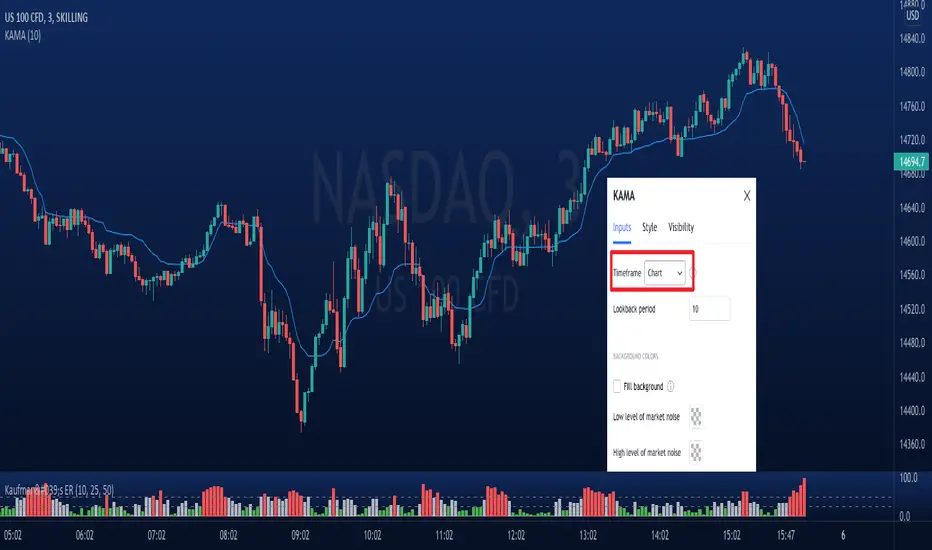OPEN-SOURCE SCRIPT
已更新 Kaufman's Adaptive Moving Average (KAMA) - Multi timeframe

Kaufman's Adaptive Moving Average (KAMA)
KAMA was developed by Perry Kaufman to give better directions of short term market trends.
Idea is similar to an EMA, but it makes adjustments to the smoothing factor by taking Market Noise into consideration. Levels of noise in KAMA is modelled using Kaufman's Efficiency Ratio.
The problem with traditional of moving averages (ie. SMA/EMA) is that they are very sensitive to sudden price movements.
Applications:
- Less prone to false signals compared to other types of moving averages. When price suddenly surges or tanks, KAMA will lag behind telling us that the move is rather abnormal.
- On the other hand, when volatility of price movements is low, KAMA will be close to the ranging candles with a slope approximate to zero. KAMA can be used for filtering out choppy markets.
Other features:
- Multi-timeframe.
- Can visualize levels of market noise with background color mode turned on.
KAMA was developed by Perry Kaufman to give better directions of short term market trends.
Idea is similar to an EMA, but it makes adjustments to the smoothing factor by taking Market Noise into consideration. Levels of noise in KAMA is modelled using Kaufman's Efficiency Ratio.
The problem with traditional of moving averages (ie. SMA/EMA) is that they are very sensitive to sudden price movements.
Applications:
- Less prone to false signals compared to other types of moving averages. When price suddenly surges or tanks, KAMA will lag behind telling us that the move is rather abnormal.
- On the other hand, when volatility of price movements is low, KAMA will be close to the ranging candles with a slope approximate to zero. KAMA can be used for filtering out choppy markets.
Other features:
- Multi-timeframe.
- Can visualize levels of market noise with background color mode turned on.
版本注释
New feature: Coded candles to identify price crossing with MA.版本注释
Amended line 43, calling of nz(src=kama, replacement=close). Previously, param. replacement==0版本注释
Features:- Added: Option to show smooth KAMA (least of squares over same KAMA period).
- Added: Low/high thresholds for background colors linked to noise (if turned on)
- Removed: bar colors during crosses
开源脚本
秉承TradingView的精神,该脚本的作者将其开源,以便交易者可以查看和验证其功能。向作者致敬!您可以免费使用该脚本,但请记住,重新发布代码须遵守我们的网站规则。
Read Faster & Learn Anything with Coral AI! getcoralai.com//?ref=dojiemoji
免责声明
这些信息和出版物并非旨在提供,也不构成TradingView提供或认可的任何形式的财务、投资、交易或其他类型的建议或推荐。请阅读使用条款了解更多信息。
开源脚本
秉承TradingView的精神,该脚本的作者将其开源,以便交易者可以查看和验证其功能。向作者致敬!您可以免费使用该脚本,但请记住,重新发布代码须遵守我们的网站规则。
Read Faster & Learn Anything with Coral AI! getcoralai.com//?ref=dojiemoji
免责声明
这些信息和出版物并非旨在提供,也不构成TradingView提供或认可的任何形式的财务、投资、交易或其他类型的建议或推荐。请阅读使用条款了解更多信息。